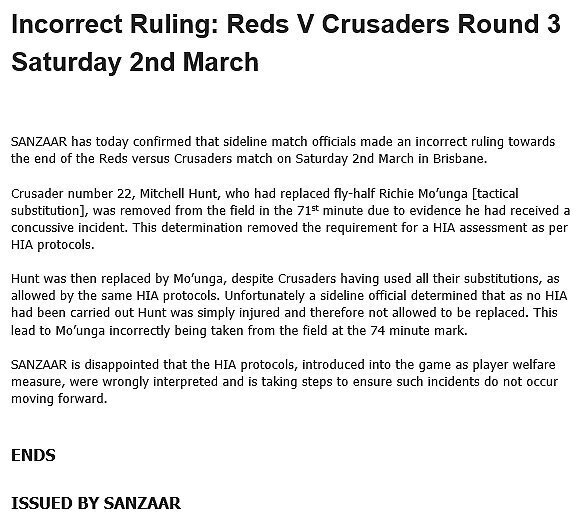Law discussion - HIA and subbing
Towards the end of the match between the Reds and the Crusaders in Brisbane on Saturday, there was an intervention that led to the Crusaders’ being reduced to 14 men for the last six minutes of the match.
This follows what seemed to be a failed head injury assessment on a substitute player.
On 58 minutes, Mitchell Hunt of the Crusaders came on as a substitute for flyhalf Richie Mo’unga. Mo’unga was clearly not injured. It was a tactical substitution, the fourth by the Crusaders.
On 71 minutes, Hunt passes to his right and then is lifted up and dumped on his back by Duncan Paia’aua of the Reds. As Hunt lands on the ground, his head seems to jerk back and hit the ground. There follows a break in play and two men with MEDIC on each of their yellow bibs attend to Hunt. There is clearly concern about his head and eventually he gets to his feet, looking somewhat dazed, and walks off between two ladies. They go down the tunnel. There is no obvious HIA next to the field.
At this stage Mo’unga returns to play.
On 74 minutes, the referee receives a message from the touchline that Mo’unga is required to leave the field. The referee and Mo’unga run across the field to the touchline where a man, dressed in a referee’s uniform, says to the referee: “They [Crusaders] have completed their eight sub. The player who’s come off is category one [sic]. He’s not getting an HIA [Head Injury Assessment] and so is an injured player, which means they can’t put a presubstitute on, because they’ve used all their subs and so they need to play with 14 players.”
The referee then turns to Mo’unga and has a slightly different story as he says: “The HIA didn’t pass and so you have to go.” And Mo’unga drifts back to the bench.
For a Super Rugby match, a team is allowed to have eight replacements and is allowed to use all eight.
These were the Crusaders’ replacements with, in brackets, whom they replaced and when: 16 Ben Funnell (Makalio, 61 minutes), 17 Harry Allan (Moody, 51 minutes), 18 Michael Alaalatoa (Franks, 61 minutes), 19 Luke Romano (Barrett, 51 minutes), 20 Jordan Taufua (Todd, 50 minutes), 21 Bryn Hall (Drummond, 50 minutes), 22 Mitchell Hunt (Mo’unga, 58 minutes), 23 David Havili (Goodhue, 61 minutes).
That accounts for all eight substitutions, all of them tactical, none related to any possible form of injury.
It’s time to look at the Laws of the Game.
First of all let’s see when one of the eight substituted players (the eight in brackets) could come back onto the field.
Law 3.33 TACTICAL REPLACEMENTS JOINING THE MATCH
Tactically replaced players may return to play only when replacing:
a. An injured front-row player.
b. A player with a blood injury.
c. A player undertaking an HIA.
d. A player who has just been injured as a result of foul play (as verified by the match officials).
e. The nominated player described in Law 3.19 or 3.20. [This refers to front row players, which is not applicable in the incident under discussion.]
It seems that Law 3.12 (c) would apply if Hunt was indeed undergoing a ahead injury assessment (HIA). In fact, Hunt’s departure from the field had all the signs that he was on his way to the HIA.
Mo’unga comes back onto the field on 71 minutes. But three minutes later there is an intervention with advice that Mo’unga not be allowed to play.
At matches of this nature, there are, apart from the referee, the assistant referees and a TMO, mother helpers to keep time and those who regulate the coming and going of players during the match.
Part of the job of those who keep time is to monitor the time of those sent to the sin bin, those off bleeding and those off for HIA. Then there are two men, usually in referee garb and usually referred to as No.4 and No.5, assigned to each side to monitor the coming and going of players.
They will control substitutions and replacements, the reintroduction players whose sin-binning is over or whose bleeding is under control or whose HIA showed no signs of concussion.
Let’s look at the Laws that would apply to Mo’unga’s return if Hunt was having an HIA.
Law 3. 27 Temporary Replacement – Head Injury Assessment (HIA)
In elite adult matches, which have been approved in advance by World Rugby (pursuant to Regulations 10.1.4 and 10.1.5) for use of the HIA process, a player who requires an HIA:
a. Leaves the field of play; and
b. Is temporarily replaced (even if all the replacements have been used). If the player is not available to return to the field of play after 10 minutes (actual time) of leaving the playing area, the replacement becomes permanent.
Even though the Crusaders had used all their replacements, Mo’unga was still allowed back on while Hunt had his test. And if Hunt failed the test and thus became an injured player, “the replacement becomes permanent”. Mo’unga stayed.
But if there was in fact no HIA and Hunt was an injury, Mo’unga was not allowed back on in the first place as he did not fall under the cases in Law 3.33 quoted above.
As a matter of interest, there is also law governing the procedure for Mo’unga’s return to play.
Law 6.6 DUTIES OF THE REFEREE DURING A MATCH
The referee permits access to the playing area for players and replacements, when it is safe to do so.
If there was no HIA, it is strange that Mo’unga was allowed back – or just went back – onto the field for the three minutes that he was there.
*The category one, referred to by the No.4, is a mystery.
By Paul Dobson
@rugby365com
- The SANZAAR statement:




































